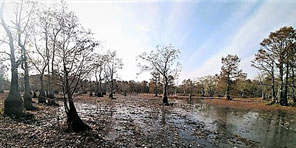CAPE GIRARDEAU, Mo. – Missouri Department of Conservation (MDC) staff were busy this past summer with habitat projects on three managed wetlands in southeast Missouri: Otter Slough, Duck Creek, and Ten Mile Pond.

Otter Lake is seen following recent work completed by MDC. A greater diversity of plants can now thrive in the lake, which will improve the overall habitat for years to come.
“Going dry is a part of the natural process for our wetlands in Missouri,” said MDC Wildlife Management Biologist John Marshall. “Some wetlands may only naturally dry out completely once every decade or so.”
Otter Slough

MDC staff were busy this past summer with habitat projects on three managed wetlands in southeast Missouri: Otter Slough (seen here), Duck Creek, and Ten Mile Pond.
Marshall said the drought overlapped planned habitat work on Otter Lake, a 250-acre cypress-tupelo swamp, on Otter Slough Conservation Area in Stoddard County. Area staff facilitated the use of contractors to mulch up many of the willows that invaded Otter Lake when it was drawn down for the first time, more than 20 years ago.
“The lake has been drawn down several times prior, but wet weather typically allowed only small parts of the lake to get treated each time,” said Marshall. “Hunters will notice the lake looks a bit different this year; we were able to tackle most of what willows were left after the initial dewatering.”
Mulching the willows allow for a greater diversity of plants to grow in the lake, which will improve the overall habitat for years to come. Staff began pumping water back into the lake in early October, but Marshall said water levels may be lower than normal for the seven hunting positions on the lake during the early part of the waterfowl season.
“Barring any well malfunctions,” he said, “the rest of the wetland impoundments should be flooded as they have been in previous years. The lack of rain makes it slower to flood managed impoundments.”
Duck Creek

The 6,318-acre Duck Creek Conservation Area in Stoddard, Wayne, and Bollinger counties is flooded with a combination of wells (seen here; Unit A, 8-10) and from water impounded in a nearby 1,800-acre
MDC Wildlife Management Biologist Nicky Walker said the 6,318-acre Duck Creek Conservation Area in Stoddard, Wayne, and Bollinger counties is flooded with a combination of wells and from water impounded in a nearby 1,800-acre reservoir on the area.
“The areas we flood with wells, like Unit A, will provide excellent habitat for waterfowl and other wetland-dependent wildlife,” said Walker. “Unfortunately, much of our flooded timber opportunities rely on water stored in our Pool 1 reservoir. With the drought conditions, we plan to only have enough water to flood one timber pool. “
The current plan is to flood Pool 2 as what normally would happen when soil temperatures drop, and trees go dormant. But currently there is not a sufficient water supply to flood Pool 3 or 8.
“If we get enough rain to refill Pool 1, we can then evaluate what additional flooded timber opportunities we can provide this season,” she said.
Walker said bottomland hardwoods historically didn’t flood every year and are usually only flooded for short periods of time over the course of fall and winter. Being dry for periods of time throughout the fall, winter, and spring is a part of the natural process.
Ten Mile Pond
MDC Wildlife Management Biologist Tyler Shirley said the 3,755-acre Ten Mile Pond Conservation Area in Mississippi County has “phenomenal” habitat for waterfowl.
“The only issue is if we’ll be able to get much of that habitat flooded,” he said. “Two of the three wells used to flood the west side of the area have failed and are inoperable for the course of the season.”
Shirley said the last functional well in this wetland unit has been utilized to add water to impoundments since August – along with a tractor and mobile pump – to transport water from the nearby ditch into the adjacent wetland impoundments.
Even with starting early and using different methods to flood, hunters may experience lower-than-normal water levels on parts of the area, according to Shirley. And that will hold true unless the weather changes.
Additional efforts to improve waterfowl hunting and viewing opportunities on Ten Mile Pond are also in the works, he said.
“We have worked diligently to evaluate waterfowl refuges on the area and engaged in numerous conversations on the pros and cons of changing refuge boundaries,” said Shirley. “We’re moving a portion of the waterfowl refuge to be in a more central location to the area.
This process will take some old refuge units and make them hunting units, and turn some hunting units into refuge units, he explained.
Shirley said staff will be diligently monitoring waterfowl use and hunting quality over the next few years, to thoroughly evaluate this change. But overall, he said, hunting opportunities should remain consistent for all users.
MDC Southeast Regional Administrator Matt Bowyer said staff at all three of the wetland areas are excited for the upcoming season and are looking forward to greeting the thousands of waterfowl hunters that use the areas annually.
“Staff are happy to discuss habitat work done on the areas if you have questions at the completion of the morning draw each day,” said Bowyer.
Access daily messages containing critical area information for each of the areas by phone daily. The phone numbers are listed below:
Duck Creek – (573) 222-3337
Otter Slough – (573) 624-5821
Ten Mile Pond – (573) 649-9491

